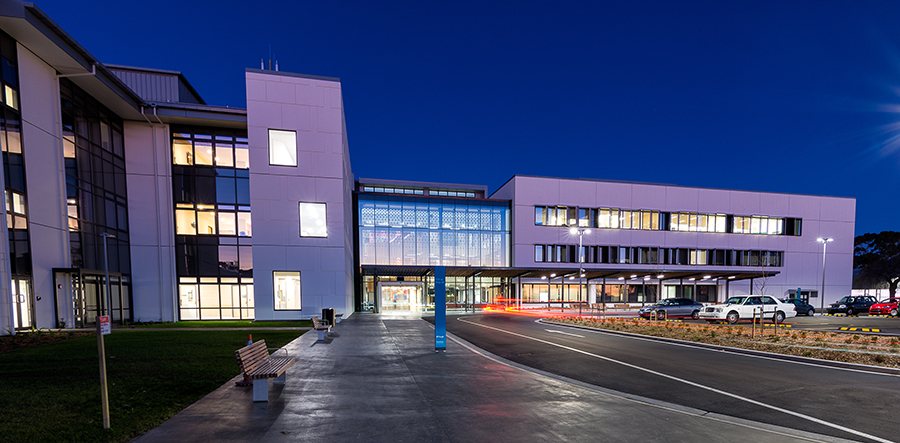- Home
-
Products
- Panels, Networking & Utilities Software
- Detectors, MCPs & Modules
- Alarm (Alerting) Devices
- Power Supplies
- Waterflow Devices
- Spare Parts
- Historic Products
- News
- Downloads
- Tools
- Projects
- About
- Support
- Sitemap
- BPIR
- Contact
Projects
Burwood Hospital’s Pertronic Fire Alarm System Accurately Identifies the Location of any Alarm

There is a growing need for fire detection systems that rapidly and accurately pin-point the exact location of any fire incident. This is especially important when building occupants cannot easily evacuate if the fire alarm is activated.
The redevelopment of Christchurch’s Burwood Hospital has shown how these requirements can be satisfied using readily-available products that are straightforward and cost-effective to install. Advanced fire detection systems accurately pin-point the source of an alarm. A PC-based graphic system such as Pertronic FireMap® automatically displays this information on a map or floor-plan of the affected area.
Hospital fire alarm systems present unique challenges. Many patients cannot evacuate without help. Others may be especially vulnerable because of illness or injury. Some depend on life support systems that are difficult to pick up and move. In addition to these basic system requirements, Burwood Hospital’s fire systems had to meet the needs of aged-care and mental health patients.
Located in Christchurch’s western suburbs, Burwood Hospital had been earmarked for expansion before the earthquakes of 2010/11. In 2013, the Government fast-tracked the project. Construction at Burwood began in early 2014, and the $215 million, 32,000 square metre, redevelopment was completed in mid-2016. The project consisted of three new three-storey buildings providing for 230 new inpatient beds, a new main entrance, and extended radiology, outpatient and procedural areas, together with a new kitchen and support area. A fourth building accommodates a wood-fired heating boiler.
Christchurch-based Compliance Fire Protection Limited (CFPL) installed the fire alarm system, which is based on a network of Pertronic analogue addressable fire alarm control panels, including three F120A control panels in the main buildings and an F100A in the boiler-house. CFPL also upgraded and connected two existing control panels (an F120A and an F100A) into the network.
Although the buildings are fully covered by an automatic sprinkler system, that system cannot pin-point the source of an alarm. Instead, this detailed information comes from the fire alarm system, which features point-type sensors in every room. For example, each individual bathroom has its own heat detector alongside the fire sprinkler. Analogue addressable technology allows the control panels to identify each individual sensor.
In addition to the point-type smoke detectors throughout the complex, optical-beam detectors have been installed in the main entrance, which has a very high ceiling. The main switchboard and server cabinets in the boiler-house are covered by aspirating smoke detectors. Aspirating smoke detectors are also installed in the mental health wards, to prevent patients from interfering with sensors and eliminate items patients could use to harm themselves or others.
The main goal of a hospital fire alarm system like Burwood is to identify, contain and eliminate any potential fire-related problems as soon as possible. That’s where the graphics system is so important. If a detector is activated, Pertronic FireMap® system automatically loads a floor plan showing the exact location of the device that triggered the alarm. As an incident unfolds, the software shows exactly where the fire alarm system has detected smoke or heat. This dramatically improves the ability of first responders and hospital staff to look after everyone in the hospital.
Advanced fire detection systems significantly improve the safety of large, complex facilities. However, the potential benefits can be realised only if the technology is practical to install and maintain. Pertronic alarm systems are designed for efficient, cost-effective installation and commissioning. “It was all pretty straightforward, even the FireMap installation,” said Russell Penn, Alarms Manager at CFPL.
Posted in Hospital; Tagged NZ - Canterbury;
Categories
- Accommodation
- Aged Care
- Apartment Building
- Art Gallery
- Arts Centre
- Café
- Court House
- Educational
- Energy
- Entertainment
- Event Centre
- Government Building
- Health Care
- Hospital
- Hotel
- Office Building
- Pavilion
- Prison
- Retail
- Retirement Village
- Sawmills
- Scott Base
- Shopping Mall
- Sports Venue
- Transport Centre
- Tunnel
- Underground Car Park

